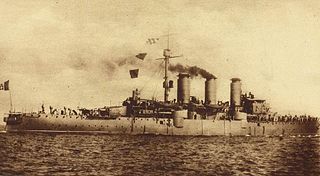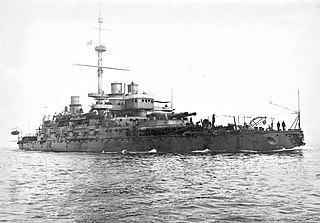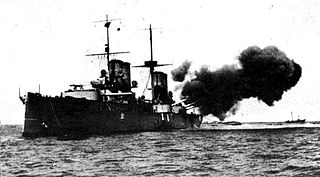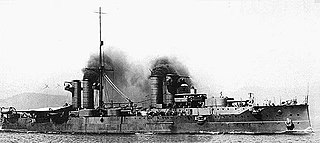
Enrico Dandolo was the second of two Duilio-class ironclad turret ships built for the Italian Regia Marina in the 1870s. They were fitted with the largest guns available, 450 mm (18 in) rifled, muzzle-loading guns, and were the largest, fastest and most powerful ships of their day. Enrico Dandolo was built in La Spezia, with her keel laid in January 1873 and her hull launched in July 1878. Construction was finally completed in April 1882 when the ship, named for the 41st Doge of Venice, was commissioned into the Italian fleet.

Amalfi was a Pisa-class armored cruiser of the Italian Royal Navy built in the first decade of the 20th century. During the Italo-Turkish War of 1911–1912, Amalfi operated with the Italian fleet off Tripoli in September 1911 and participated in the amphibious landings at Derna in October. In April 1912, Amalfi and sister ship Pisa led the way in attacks on Turkish forts in the Dardanelles. After the rest of the fleet retired later in the month, the pair of armored cruisers remained in the area to attack Turkish communications facilities. After the Treaty of Lausanne signed in October 1912 ended the war, Amalfi escorted the Italian king and queen on the royal yacht to Germany and Sweden during a 1913 visit.

The Pisa class consisted of three armored cruisers built in Italy in the first decade of the 20th century. Two of these were for the Royal Italian Navy and the third was sold to the Royal Hellenic Navy and named Georgios Averof. This ship served as the Greek flagship for the bulk of her active career and participated in the Balkan Wars of 1912–1913, fighting in two battles against the Ottoman Navy. She played a minor role in World War II after escaping from Greece during the German invasion in early 1941. Influenced by communist agitators, her crew mutinied in 1944, but it was suppressed without any bloodshed. Georgios Averof returned to Greece after the German evacuation in late 1944 and became a museum ship in 1952. She is the only surviving armored cruiser in the world.

Francesco Ferruccio was a Giuseppe Garibaldi-class armored cruiser built for the Royal Italian Navy in the first decade of the 20th century. The ship made several deployments to the Eastern Mediterranean and the Levant during her career. At the beginning of the Italo-Turkish War of 1911–12 she bombarded Tripoli and then Beirut in early 1912 before being transferred to Libya. During World War I, Francesco Ferruccio's activities were limited by the threat of Austro-Hungarian submarines and she became a training ship in 1919. The ship was struck from the naval register in 1930 and subsequently scrapped.

Varese was a Giuseppe Garibaldi-class armored cruiser built for the Royal Italian Navy in the 1890s. The ship made several deployments to the Eastern Mediterranean and the Levant before the start of the Italo-Turkish War of 1911–12. She supported ground forces in the occupations of Tripoli and Homs in Libya. Varese may have bombarded Beirut and did bombard the defenses of the Dardanelles during the war. She also provided naval gunfire support for the Italian Army in Libya. During World War I, the ship's activities were limited by the threat of Austro-Hungarian submarines and Varese became a training ship in 1920. She was struck from the naval register in 1923 and subsequently scrapped.

Giuseppe Garibaldi was the seventh ship of the Giuseppe Garibaldi class of armored cruisers built for the Royal Italian Navy in the 1890s. She was built to replace the lead ship of her class, which was sold to Argentina and renamed ARA Garibaldi. The ship often served as a flagship and made several deployments to the Eastern Mediterranean and the Levant during her career. At the beginning of the Italo-Turkish War of 1911–12 she bombarded Tripoli. Giuseppe Garibaldi bombarded Beirut in early 1912 and sank an Ottoman ironclad there. Several months later she bombarded the defenses of the Dardanelles.

Sicilia was the second of three Re Umberto-class ironclad battleships built for the Italian Regia Marina. The ship, named for the island of Sicily, was laid down in Venice in November 1884, launched in July 1891, and completed in May 1895. She was armed with a main battery of four 343 mm (13.5 in) guns and had a top speed of 20.3 knots, though this high speed came at the cost of armor protection.

Sardegna was the third of three Re Umberto-class ironclad battleships built for the Italian Regia Marina. The ship, named for the island of Sardinia, was laid down in La Spezia in October 1885, launched in September 1890, and completed in February 1895. She was armed with a main battery of four 340 mm (13.5 in) guns and had a top speed of 20.3 knots —albeit at the cost of armor protection—and she was one of the first warships to be equipped with a wireless telegraph.

Vittorio Emanuele was an Italian pre-dreadnought battleship, laid down in 1901, launched in 1904 and completed in 1908. She was the second member of the Regina Elena class, which included three other vessels: Regina Elena, Napoli, and Roma. Vittorio Emmanuele was armed with a main battery of two 305 mm (12 in) guns and twelve 203 mm (8 in) guns. She was quite fast for the period, with a top speed of nearly 21 knots.

The Italian cruiser San Giorgio was the name ship of her class of two armored cruisers built for the Royal Italian Navy in the first decade of the 20th century. Commissioned in 1910, the ship was badly damaged when she ran aground before the start of the Italo-Turkish War in 1911, although she was repaired before its end. During World War I, San Giorgio's activities were limited by the threat of Austro-Hungarian submarines, although the ship did participate in the bombardment of Durazzo, Albania, in late 1918.

The Vettor Pisani class consisted of two armoured cruisers built for the Royal Italian Navy in the 1890s. The two ships of the class, Vettor Pisani and Carlo Alberto, were frequently deployed overseas during their careers. The former served in the Far East during the Boxer Rebellion of 1900 while the latter was involved in pioneering long-range radio experiments several years later before deploying to South American waters. Carlo Alberto then served as a training ship for several years. Both ships participated in the Italo-Turkish War of 1911–12 and played minor roles in World War I, during which time Carlo Alberto was converted into a troop transport and Vettor Pisani into a repair ship. They were both discarded in 1920 and subsequently scrapped.

The Italian cruiser San Marco was a San Giorgio-class armoured cruiser built for the Royal Italian Navy in the first decade of the 20th century. She was the first large Italian ship fitted with steam turbines and the first turbine-powered ship in any navy to have four propeller shafts. The ship participated in the Italo-Turkish War of 1911–1912, during which time she supported the occupations of Benghazi and Derna, the island of Rhodes, and bombarded the fortifications defending the entrance to the Dardanelles. During World War I, San Marco's activities were limited by the threat of Austro-Hungarian submarines, although the ship did participate in the bombardment of Durazzo, Albania in late 1918. She played a minor role in the Corfu incident in 1923 and was converted into a target ship in the first half of the 1930s. San Marco was captured by the Germans when they occupied northern Italy in 1943 and was found sunk at the end of the war. The ship was broken up and scrapped in 1949.

The San Giorgio class consisted of two armored cruisers built for the Royal Italian Navy in the first decade of the 20th century. The second ship, San Marco, was used to evaluate recently invented steam turbines in a large ship and incorporated a number of other technological advances. The ships participated in the Italo-Turkish War of 1911–1912, although San Giorgio was under repair for most of the war. San Marco supported ground forces in Libya with naval gunfire and helped them to occupy towns in Libya and islands in the Dodecanese. During World War I, the ships' activities were limited by the threat of Austro-Hungarian submarines, although they did bombard Durazzo, Albania in 1918.

Piemonte was a unique protected cruiser built for the Italian Regia Marina in the 1880s by the British shipyard Armstrong Whitworth. She was the first major warship armed entirely with quick-firing (QF) guns and she was also the fastest cruiser in the world upon her completion in 1889. Piemonte was frequently deployed overseas, including a lengthy tour in East Asian waters from 1901 to 1904. She saw significant action during the Italo-Turkish War in 1911–1912 in the Red Sea, where she frequently bombarded Ottoman ports. During the Battle of Kunfuda Bay in January 1912, she and two destroyers sank four Ottoman gunboats and forced ashore three more. Piemonte participated in World War I but she saw little action during the conflict. She remained in service until 1920, when she was scrapped.

The Agordat class was a pair of torpedo cruisers built by the Italian Regia Marina in the late 1890s. The two ships, Agordat and Coatit, were armed with twelve 76 mm (3 in) guns and two 450 mm (17.7 in) torpedo tubes. They proved to be too slow and have too short a cruising radius to be of much use, so their service careers were limited. Their most significant action came during the Italo-Turkish War of 1911–1912, where both ships were employed in shore bombardment duties. Neither ship saw action in World War I. Coatit was converted into a minelayer in 1919 and sold for scrapping the following year, while Agordat was rearmed as a gunboat in 1921; she followed her sister to the breakers in 1923.

Marco Polo was an armored cruiser built for the Royal Italian Navy in the 1890s, the first of her type in Italian service. The ship spent the bulk of her career deployed in the Far East. Between deployments she participated in the Italo-Turkish War of 1911–12 during which she caused a diplomatic incident with the Austro-Hungarian Empire. After that affair Marco Polo was sent to Libya where she bombarded the towns of Homs, and Zuara and the defenses of the Dardanelles. In between these operations, the ship provided naval gunfire support to the Royal Italian Army in Libya. Due to her age, Marco Polo did not play a significant role in World War I, serving as an accommodation ship in Venice until she began conversion into a troopship in 1917. After a series of renamings in 1920–21, the ship was stricken from the naval register in 1922 and subsequently sold for scrap.

The Italian cruiser Vettor Pisani was the name ship of her class of two armored cruisers built for the Royal Italian Navy in the 1890s. She often served as a flagship during her career and frequently served overseas. On one of these deployments, the ship received a radio message from Peking, one of the first long-range radio transmissions to a ship. Vettor Pisani participated in the Boxer Rebellion of 1900 and the Italo-Turkish War of 1911–12, during which her admiral nearly caused a diplomatic incident with the Austro-Hungarian Empire. During World War I, her activities were limited by the threat of Austro-Hungarian submarines and she was converted into a repair ship in 1916. Vettor Pisani was stricken from the Navy List in 1920 and scrapped later that year.

The Italian cruiser Pisa was the name ship of her class of two armored cruisers built for the Royal Italian Navy in the first decade of the 20th century. The ship participated in the Italo-Turkish War of 1911–1912, during which she supported the occupations of Tobruk, Libya and several islands in the Dodecanese and bombarded the fortifications defending the entrance to the Dardanelles. During World War I, Pisa's activities were limited by the threat of Austro-Hungarian submarines, although the ship did participate in the bombardment of Durazzo, Albania in late 1918. After the war she became a training ship and was stricken from the Navy List in 1937 before being scrapped.

Urania was a torpedo cruiser of the Partenope class built for the Italian Regia Marina in the 1880s. She was built by the Cantieri navali Odero shipyard; her keel was laid in February 1889, she was launched in June 1891, and was commissioned in July 1893. Her main armament were her six torpedo tubes, which were supported by a battery of ten small-caliber guns. Urania spent most of her career in the main Italian fleet, where she was primarily occupied with training exercises. She was still in service at the outbreak of the Italo-Turkish War in September 1911, but she did not take part in any operations. Instead, she remained in Italian waters and was broken up for scrap in January 1912.

Iride was a torpedo cruiser of the Partenope class built for the Italian Regia Marina in the 1880s. Laid down in February 1889 at the Regio Cantiere di Castellammare di Stabia shipyard, she was launched in July 1890 and was commissioned in November 1892. Her main armament were her six torpedo tubes, which were supported by a battery of ten small-caliber guns. Iride spent most of her career in the main Italian fleet, where she was primarily occupied with training exercises. During the Italo-Turkish War in September 1911, she remained in Italian waters until late in the conflict; she escorted a troop convoy to North Africa in April 1912 and bombarded Ottoman positions in June and July. Iride was eventually broken up for scrap in December 1920.




















